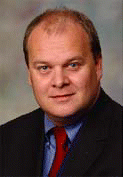We think there are several implications of this study, Dr. O’Donnell told ENT Today. Assuming that unblinding confirms our interpretation of the blinded data, a fungal-induced inflammation as the cause of chronic sinusitis is a valid paradigm. It’s a host-defined disease where only 10 percent of those exposed to fungi mount an inflammatory response characterized by eosinophils.
Explore This Issue
March 2008He added that Mayo was right. A topical intranasal administration of extremely low doses of antifungals looks like it will be significantly effective at reducing the symptoms and inflammatory changes in the nose and in the sinuses. The clinical trial is suggesting that the vast majority of bona fide CRS cases are due to the fungal-induced inflammation. Although patients in the Phase III study were not selected on the basis of whether or not they had nasal mucin that was positive for eMBP, after enrollment, every patient has tested positive so far for eMBP.
Clearly, the results are incompatible with what was shown by Weschta and Ebbens, Dr. O’Donnell further stated, noting that the studies by the European researchers showed no effect on symptoms or signs, whereas the Accentia trial with 302 patients indicates at the still-blinded point that roughly half of the patients have a significant resolution-not just a reduction in severity-of symptoms and improvement in endoscopy and CT scans of the sinuses.
Dr. Ebbens cautioned, however, that the Accentia results may reflect a placebo effect. Before drawing any conclusions, we should await the unblinded results, she said.
This is the first time that anything for CRS has made it into an FDA-approved Phase III trial, Dr. Ponikau said. No drug or treatment has ever gone that far for CRS. We are careful in what we are saying; we’re saying it’s in development and we’re learning a lot about it, but we’re not there yet.
A lot of patients are going to benefit from the research at the Mayo Clinic, Dr. O’Donnell added. But that research met with incredible skepticism because many people failed to understand what Mayo was saying. They weren’t saying that if you had the fungus, you had the disease. Rather, they were saying it’s a host-defined disease. Virtually everyone has the fungus in the mucus of their nose and sinus. But only 10 percent of the population has an inflammatory response to it.
Maybe Not for Everyone
Neil Bhattacharyya, MD, Associate Professor of Otolaryngology at Brigham and Women’s Hospital and Harvard Medical School in Boston, would agree, but with a caveat. He said, Amphotericin B is one of the members of our armamentarium that we use to treat chronic rhinosinusitis-in certain cases. I think it has a role in the treatment of a certain subset of CRS, but it’s not, in my opinion, going to be the end-all, be-all answer for why those patients don’t do well with traditional therapy or surgery.

Leave a Reply